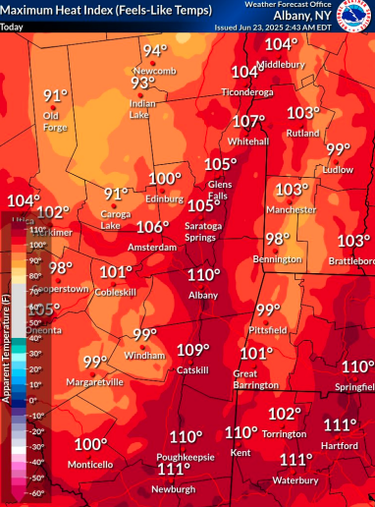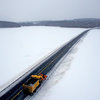Officials urge caution as region hunkers down during heat wave
ALBANY COUNTY — The current heat wave peaked today, June 23, with a heat index reading of 110 degrees in Albany, according to the National Weather Service.
The dangerous heat and humidity is caused by temperatures in the 90s and dew points in the upper 60s. Overnight lows in the upper 60s and low 70s and continued humid conditions will not provide much nighttime relief from the hot temperatures, the service says.
The “feels like” reading is supposed to decrease slightly on Tuesday to 107 degrees in Albany, which is still in the “danger” zone where heat cramps or heat exhaustion is likely and heat stroke is possible with physical activity, according to the Weather Service.
Isolated to widely scattered thunderstorms are expected to develop across the region on Tuesday, the Weather Service says, adding, “Main threats would be damaging wind gusts within the strongest storms along with some hail.”
By Wednesday, the Weather Service forecasts a heat index of 97 degrees in Albany and then, on Thursday, 82 degrees — which is finally out of the “danger” zone and in a “caution” zone where fatigue is possible with prolonged exposure or physical activity.
The Weather Service says, “Heat is one of the most deadly weather hazards — don’t underestimate it.”
The service advises: Never leave people or pets alone in a closed car; drink plenty of water, even if you don’t feel thirsty; wear loose-fitting, light-colored clothing; and spend time in air-conditioning and in the shade.
On Sunday, Governor Kathy Hochul declared a state of emergency in 32 counties, including Albany County, in response to severe weather and extreme heat.
Also on Sunday, Albany County executive Daniel McCoy put out a release that lists cooling stations county-wide, including municipal buildings like Bethlehem Town Hall, public libraries like the one in Westerlo, and municipal parks with spray pads.
“As extreme heat settles over the Capital Region, I urge everyone to take the proper precautions, including drinking plenty of water,” said McCoy in the release. “This kind of weather can be dangerous, especially for seniors, young children, and those with underlying health conditions. Let’s remain vigilant and take care of one another the way our community always does.”
After several days of exposure to high temperatures and inadequate hydration, heat exhaustion may develop, the county release said. The elderly and those with high blood pressure are the most vulnerable. Heavy perspiration, paleness, cramping in the muscles, fatigue, weakness, headache, nausea, vomiting, and fainting are some of the symptoms. Skin could be damp and cold. Pulse rate will be fast and weak, and breathing will be fast and shallow. If heat exhaustion is untreated, it may progress to heat stroke.
Heat Stroke is the most serious heat-related illness and occurs when the body can’t control its temperature and could be deadly, the release said. Symptoms include an extremely high body temperature (above 103'F), red, hot, and dry skin (no sweating), rapid, strong pulse, throbbing headache, dizziness, nausea, confusion and unconsciousness.
Hochul also recently announced a suite of actions to help New Yorkers stay cool during extreme heat events this summer, including support for air-conditioning at home through the Home Energy Assistance Program, known as HEAP and better access to cooling centers with a Cooling Center Finder.
During heat waves, increased use of electric devices such as air-conditioners place a considerable demand on the state’s electricity system and instances of low voltage or isolated power outages can result, according to the state’s Department of Public Service.
The record for such usage was set on July 19, 2013, when it reached 33,956 MWs (one megawatt of electricity is enough to power up to 1,000 average-sized homes).
“There are no operational problems on the transmission system and there is sufficient generation scheduled to meet today’s peak load,” the department said on June 18 in anticipation of the heat wave.
The state’s health department cites resources at the CDC’s extreme heat website and the State Health Department’s extreme heat advice webpage.
The health department’s interactive Heat Risk and Illness Dashboard allows the public and county health care officials to determine the forecasted level of heat-related health risks in their area and raise awareness about the dangers of heat exposure.
Information about what to do during hot weather and how to locate cooling centers may be found at the health department’s Extreme Heat website.



